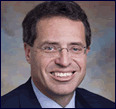The OakmarkFund’s Bill Nygren published his 3Q10 Quarterly letter. In the letter, Nygren commented on the following three new investment he made during the quarter:
Read the full letter here.
Exxon Mobil (XOM - $62)
Exxon Mobil is the largest publicly traded oil company. XOM is widely considered to be a high quality operator with a superior cost structure. That has resulted in higher returns on capital than most of its competitors. XOM is also known for good financial management. Its balance sheet is pristine, holding more cash than total indebtedness. Its dividend has roughly doubled over 10 years and provides a current yield of nearly 3%. Additionally, management has consistently used excess cash to reduce the number of outstanding shares. In 1999, when Exxon bought Mobil, shares outstanding increased from 4.9 billion to 7.0 billion. Management has reduced the number of shares outstanding in each subsequent year. With the share base now at 4.5 billion, the company has fewer shares outstanding than it did before it acquired Mobil. We expect XOM management to continue repurchasing shares and to continue increasing the dividend. The stock trades at about 10 times expected forward earnings and yields more than a 10-year Treasury. With modest earnings growth and a shrinking share base, we believe XOM per-share-value will grow more rapidly than most companies. With a cash-rich balance sheet, low P/E and high dividend yield, XOM will, in our view, be less risky than most stocks. We always strive to be positioned for above-average return with below-average risk.
Aflac (AFL - $52)
Aflac is the world’s largest underwriter of supplemental cancer insurance, primarily selling in Japan. We have previously owned AFL in Oakmark. Its enviable track record of compounding earnings per share growth at 15% for the past decade compares favorably with many stocks that would be categorized as growth stocks. In early 2008, the market rewarded AFL with a price above $60 when trailing earnings were a little above $3. At that valuation, we could no longer justify holding it. Subsequent to our sale, the business continued to prosper. Earnings per share in 2010 are expected to exceed $5, the dividend has been raised more than 40% since 2007, and there are now fewer shares outstanding than there were when we sold it. With a P/E of 10x, about half what it was when we sold the stock, we again believe AFL is a value. Normally, in addition to a high P/E, a growth stock has little or no yield. But with the higher dividend and lower stock price, AFL now yields over 2%, which exceeds the yield on a 5-year Treasury. As pitchman Yogi Berra would say, if you own AFL, “they give you cash, which is just as good as money.”
Northrop Grumman (NOC - $61)
Northrop Grumman is a large defense contractor. From 2000 to 2002 NOC rapidly expanded its size by acquiring Litton Industries, Newport News and TRW. To fund the acquisitions, NOC issued both stock and debt. Shares outstanding went from 144 million at the end of 2000 to 365 million two years later. Likewise, long-term debt went from $1.6 billion to over $9 billion. The share price peaked in 2002 at $68, when EPS was $2.86 and the dividend was 80 cents. As often happens after large acquisitions, earnings estimates fell short, and integration took longer than planned. Now eight years later, the company has a new CEO, its shares outstanding are nearly 20% fewer, debt is less than half what it was, and EPS and the dividend have more than doubled. Yet the stock price is lower. The stock now sells at about 10x earnings and yields nearly 3%, which is more than a 10-year Treasury. Despite the low P/E and high dividend yield, we don’t believe we are sacrificing growth prospects. We believe that modest sales growth and margin improvement will continue and that most of the retained earnings will be used to repay debt and repurchase shares. We believe that the reduction in shares outstanding will leverage below-average net income growth into above average EPS growth.
Read the full letter here.
